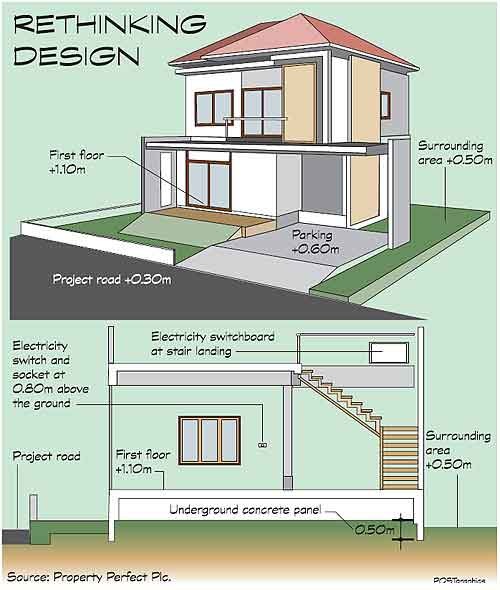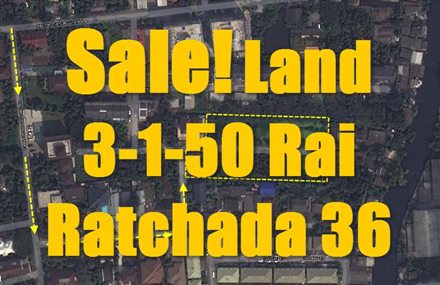Property Perfect Plc is the first developer to come up with just such a design, with three protective layers from the project location to the house itself.
Water can enter a house from visible entrances such as doors and windows or hidden openings like water drains.
To prevent outside water from backing up through water pipes, valves will be installed that can be closed anytime.
Cesspools will have a compartment in which a piece of cement board can be inserted to stop the contents from backing up into the house during flooding.
Parking spaces will be raised to 60 centimetres above the level of the public road, meaning if floodwater is one metre deep, then the parking area would be under only 40cm.
The ground floor of the house in previous designs was usually 45cm higher than the public road. In the new design, the floor is raised by another 1.1 metres, keeping it dry in one-metre floods.
The ground floor interior features a new design. All electrical switches and sockets will be installed 1.2 metres above the floor, while circuit breakers will be moved to stair landings.
Concrete panels will be run 50cm deep along underground beams on all four sides of the house to keep water from seeping underneath.
At the fence, the main gate will hang from a C-shaped cement post in which a cement board can be inserted to prevent outside water from entering the grounds. Silicone can be applied to seal the gap between the cement board and the post.
At the project level, land will be raised up another 30cm. The main entrance to the development will be lifted another 1.1 metres onto a small hill.
Below the hill will be a water retention pond with a watergate to prevent reversal through the drainage system.
Fences surrounding the entire project will be designed to prevent water from flowing above and below the ground.
A pump station and mobile pumps will be on hand, operating on electricity or diesel in case of power cuts.
"This flood protection design will add to the construction cost of a house, raising the unit price. But we believe homebuyers will agree to the expense," said chief executive Chainid Ngowsirimanee.
He also suggested larger permanent measures such as a warning system, expansion of canals, permanent dykes in at-risk areas and a floodway to help drain water into the sea.
The Chao Phraya River should have a permanent dyke in Pathum Thani and Nonthaburi to help prevent flooding.
News from ฺBangkokpost
Water can enter a house from visible entrances such as doors and windows or hidden openings like water drains.
To prevent outside water from backing up through water pipes, valves will be installed that can be closed anytime.
Cesspools will have a compartment in which a piece of cement board can be inserted to stop the contents from backing up into the house during flooding.
Parking spaces will be raised to 60 centimetres above the level of the public road, meaning if floodwater is one metre deep, then the parking area would be under only 40cm.
The ground floor of the house in previous designs was usually 45cm higher than the public road. In the new design, the floor is raised by another 1.1 metres, keeping it dry in one-metre floods.
The ground floor interior features a new design. All electrical switches and sockets will be installed 1.2 metres above the floor, while circuit breakers will be moved to stair landings.
Concrete panels will be run 50cm deep along underground beams on all four sides of the house to keep water from seeping underneath.
At the fence, the main gate will hang from a C-shaped cement post in which a cement board can be inserted to prevent outside water from entering the grounds. Silicone can be applied to seal the gap between the cement board and the post.
At the project level, land will be raised up another 30cm. The main entrance to the development will be lifted another 1.1 metres onto a small hill.
Below the hill will be a water retention pond with a watergate to prevent reversal through the drainage system.
Fences surrounding the entire project will be designed to prevent water from flowing above and below the ground.
A pump station and mobile pumps will be on hand, operating on electricity or diesel in case of power cuts.
"This flood protection design will add to the construction cost of a house, raising the unit price. But we believe homebuyers will agree to the expense," said chief executive Chainid Ngowsirimanee.
He also suggested larger permanent measures such as a warning system, expansion of canals, permanent dykes in at-risk areas and a floodway to help drain water into the sea.
The Chao Phraya River should have a permanent dyke in Pathum Thani and Nonthaburi to help prevent flooding.
News from ฺBangkokpost













 RSS Feed
RSS Feed
